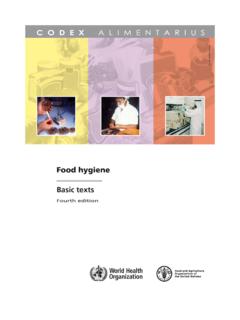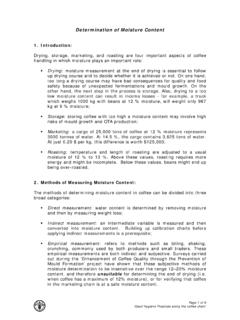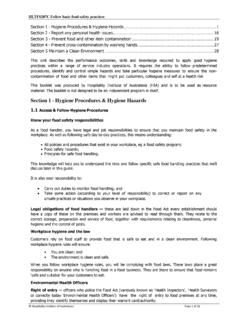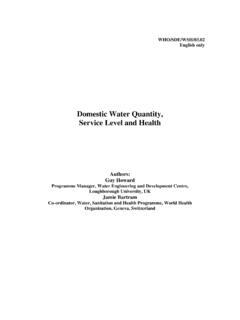Transcription of MODULE 3: FOOD SAFETY, STORAGE & PRESERVATION
1 NUTRITION TRAINING MANUAL: MODULE 3 food safety , STORAGE & PRESERVATION 1 MODULE 3: food safety , STORAGE & PRESERVATION Introduction Ensuring food safety and hygiene is important at individual, household and community level. It ensures that foods are safe for human consumption and that individuals do not develop any food -borne illnesses. This MODULE equips participants with an understanding of key food safety and food hygiene issues and how these can be maintained within households and communities. The MODULE explores different areas with regards to food safety including: food spoilage, food STORAGE and food poisoning. An assessment of the food handling, safety , STORAGE and hygiene practices by workers in Rwenzori and Mpanga tea estates revealed that: Household ownership of food STORAGE facilities varied with only 63% of households reportedly storing food Households that stored food made use of cupboards, containers, baskets, sacks and open floors to store food . Those that did not own food STORAGE facilities mentioned the lack of STORAGE space, consumption of all food prepared and the lack of money to buy food STORAGE facilities as being limiting factors to food STORAGE .
2 Respondents identified the following food hygiene practices: proper covering of food (68% of respondents), cooking of food (22% of respondents), use of clean utensils in food preparation (5% of respondents), warming of leftover food before consumption (4% of respondents) and keeping cooked and raw foods separately (1% of the respondents) Main challenges in ensuring food safety included the lack of adequate food STORAGE facilities and poor STORAGE methods that result in the destruction of stored food by pests, including cockroaches and rats Objectives of the MODULE By the end of this MODULE , participants should be able to demonstrate good practices with respect to food safety and hygiene , including through food STORAGE and PRESERVATION techniques. They will also learn how to prevent food poisoning. Overview 1. The concept of food safety and hygiene 2. food STORAGE and PRESERVATION 3. food poisoning NUTRITION TRAINING MANUAL: MODULE 3 food safety , STORAGE & PRESERVATION 2 The concept of food safety and hygiene Once food has been harvested, gathered or slaughtered, enzymes and bacteria become active in this food which cause it to deteriorate in texture and composition until it eventually becomes unfit for consumption.
3 This deterioration is known as decay and leads to eventual food spoilage. food safety and hygiene entail undertaking a series of measures to avoid spoilage and contamination of food . At the core of maintaining food safety is the need for proper food handling (incl cooking), STORAGE and PRESERVATION as these greatly influence how long a food can stay fit for consumption. food is considered safe for human consumption when it is free from substances like contaminants, toxins and micro-organisms that can cause undesirable reactions in the body when such foods are eaten. To ensure that food is safe for consumption, it should be: Protected from contamination by harmful bacteria, poison and other foreign bodies Prevented from having any bacteria present multiplying to an extent which would result in the illness of consumers or the early spoilage of the food For some foods: thoroughly cooked to destroy any harmful bacteria present Discarded when spoilt and/or contaminated The benefits of proper food safety and hygiene are: More efficient utilization of food consumed by the body contributing to improved health and nutrition outcomes Prevention of food -borne illnesses (and sometimes death) Less food wastage Causes of food spoilage Contamination of food stuffs can occur through different ways, including: inappropriate food handling at different stages throughout the food chain; poor hygienic conditions of the places where food is placed, prepared and/or stored.
4 Intentional or non-intentional mixing of food with other foods or non- food substances that are unhygienic (also known as food adulteration) and general poor environmental hygiene . food can also be contaminated when put together with other foods that have already undergone spoilage. It is normal for food to spoil when no measures are undertaken to prevent its spoilage. Naturally, foods spoil over time due to the presence of either naturally occurring enzymes in particular foods or due to other external organisms or factors. Fruits and vegetables spoil over time because of the presence of naturally occurring enzymes that cause ripening and eventually, decay. food spoilage may also be caused by micro-organisms such as moulds (commonly seen on bread), or yeasts and bacteria. These cause the food to break down, rot or go sour. The food may then discolour, smell bad or become sticky and slimy. Chemical hazards like pesticides and toxic metals may also lead to food contamination and spoilage.
5 Like other living things, micro-organisms such as bacteria, need food , warmth, moisture and time to grow and multiply. The ideal temperature for most bacteria is 30-45 C. Bacteria thrive best in damp conditions and in moist foods. When the correct conditions for growth are present, bacteria can double in number every 10 to 20 minutes, so that in about six hours 1 million could be produced from just one bacterium! As they increase in number, micro-organisms feed on nutrients present in a food leading to chemical and physical NUTRITION TRAINING MANUAL: MODULE 3 food safety , STORAGE & PRESERVATION 3 changes in the natural composition of the food and eventually food spoilage. Boiling kills most bacteria and cold temperatures slow down their growth. Freezing does not kill bacteria, it only inactivates the enzymes (they stay dormant until they defrost). Identifying spoilt food food that is spoilt can be identified in different ways: Off odours: Foods tend to develop undesirable off-flavours and/or odours as they spoil Discolouration: food undergoing spoilage normally changes in colour Slime / Stickiness: Gravy or soups sometimes become thick and slippery to touch Unusual taste: food that is undergoing spoilage often changes in taste The production of gas: Some foods - especially when stored in sealed containers develop some gases which will be noticeable when opening the container Mould growth: Other foods, bread develop fungi like growth which is easy to see with the naked eye Foods at high risk of food spoilage Some foods are prone to faster spoilage by micro-organisms than others.
6 Foods that spoil fast are usually referred to as high risk foods. Most often these are ready to eat foods or rich protein foods and require refrigerated STORAGE . Examples of these foods are: (Cooked) meat, including poultry (Cooked) meat products including gravy, stews Milk and milk products Eggs and products made from raw eggs (Cooked) Fish food cross-contamination Previously safe food can spoil when it gets contaminated by bacteria from another food in a process known as cross- contamination. For example, it may occur when raw and cooked meat are cut on the same board or when fruits and vegetables are cut on a board previously used for cutting meat on but which was not cleaned. The main carriers of bacteria and causes of cross-contamination are: Humans Rubbish Pets and other animals food , raw meat or poultry In order to avoid cross-contamination: Do not let raw meat drip onto other food and keep raw meat separate from other food Never use the same chopping board for raw meat and ready-to-eat food without washing the board (and knife) thoroughly in between Maintain personal and environmental hygiene at all times.
7 For example, always wash hands, chopping boards and utensils before starting food preparation All individuals carry bacteria in their intestines, nose, mouth and on their hands. These micro-organisms can easily be passed on to food when individuals do not maintain good hygienic practices, such as washing hands before cooking and after using the latrine. General tips for preventing food contamination and spoilage: food hygiene Keep raw and cooked meats separate to avoid cross- contamination NUTRITION TRAINING MANUAL: MODULE 3 food safety , STORAGE & PRESERVATION 4 It is useful to have a separate chopping board for raw meat. Do not put ready to eat food , such as bread, salad or fruit on a worktop or chopping board that has been touched by raw meat, unless it has been washed thoroughly first Cook eggs, meat, fish and poultry thoroughly to kill bacteria Thaw frozen meat and poultry thoroughly before cooking Cool and cover leftovers Preheat leftovers until piping hot to ensure that all bacteria are destroyed Wash fruits and raw vegetables before eating Prior to consumption, rinse fresh fruits and vegetables to remove possible pesticide residues, soil, and/or bacteria Personal hygiene Wash hands thoroughly with soap and water and dry them at each of these times: before starting to prepare food ; after touching raw meat, including poultry; after touching raw eggs; after going to the toilet.
8 After touching the bin and after touching pets or other animals Cover or tie back hair and wear a clean apron/cloth whenever you are going to prepare food Avoid touching face or hair while preparing food Keep fingernails clean and short Do not cough or sneeze over food Avoid wearing rings, earrings or watches when preparing food Cuts and wounds should be covered with a waterproof dressing A person who has been ill, especially with food poisoning, should not work with food or be in the food preparation area Kitchen hygiene Cleaning the kitchen and all areas, surfaces and utensils used for food preparation is important to keep food safe and prevent bacteria from spreading. Avoiding the build-up of refuse also leads to better hygienic conditions in a kitchen. One must ensure that the area and utensils that have been used for food preparation are cleaned before doing anything else. Clean as you go : This provides a clean environment for other food preparations. The following should be noted.
9 Ideally, the kitchen should have adequate lighting and ventilation Ensure having adequate supply of water and cleaning materials Always wash worktops/chopping tables and utensils before food preparation begins Regularly disinfect and change kitchen cloths as these are an ideal breeding ground for bacteria Use separate cloths for kitchen (dishes) and bathroom (hands and body) Keep kitchen bin covered, empty daily and disinfect once a week Disinfect worktops regularly Keep pets and all domesticated birds and animals out of the kitchen at all times-including night Sweep kitchen floor daily and wash and disinfect regularly Wipe up any spoilt foods straight away Sanitize worktops/chopping tables and utensils thoroughly (with detergent) after they have been touched by raw meat, including poultry or raw eggs Always ensure using clean utensils for serving food as this prevents the spread of bacteria NUTRITION TRAINING MANUAL: MODULE 3 food safety , STORAGE & PRESERVATION 5 Environmental hygiene The environment in which we live has a big impact on the safety and hygiene of the food that we eat.
10 For this reason, proper environmental hygiene should be maintained in our households, in the markets from where we buy household food , in homestead gardens where vegetables are grown and in all public and private areas and water sources. At household/community level we should ensure: Proper refuse disposal in designated places We use clean pit latrines/toilets (defecating and urinating should happen in designated places only) We have sufficient supplies of water, soap and other disinfectants Water places are kept clean and not used by animals To keep public places clean at all times Failure to maintain environmental hygiene may lead to waste being washed into our sources of water and food . It also leads to rapid multiplication of flies that further spread germs and bacteria. Cooking Tips All foods that are not eaten raw should be properly cooked (includes boiling, frying, roasting) Especially meat (beef, pork, chicken) should be well cooked as eating undercooked meat can lead to worms Meat that is properly cooked does not have any pink parts.






